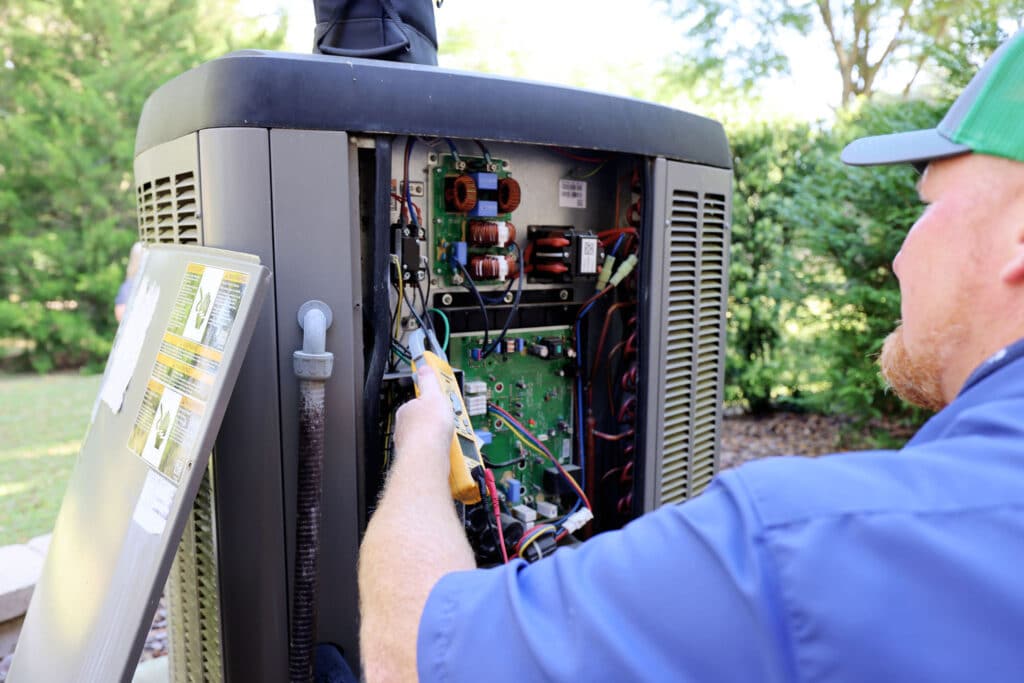HVAC systems are built to withstand our typical North Florida weather conditions. However, from June to November each year, the hurricane season can bring strong tropical storms and hurricanes to our state. These result in high-speed winds, flying debris, and flooding and can put your HVAC system to the test.
Hurricane conditions can damage your HVAC unit if you’re not ready, but our easy-to-follow HVAC checklist for hurricane season will help you know what to do to protect it before, during, and after a hurricane.
Before the Storm
One of the first steps on your HVAC checklist for hurricane season is to have regular inspections and preventative maintenance scheduled. This ensures any needed repairs are made before storms arrive. Our Comfort Temp technicians recommend an annual inspection at least to ensure that your HVAC runs optimally before hurricane season.
Trim & Discard
Once a hurricane is expected to hit your area, check your landscape for broken or dying limbs and branches. Remove them and haul them away—don’t just put them in a pile on your property, as they can scatter and become dangerous projectiles from the storm’s strong winds.
Remove Unsecured Objects
Next, relocate all unsecured patio furniture, grills, removable window awnings, and outdoor decorations to a safer location indoors. Don’t forget your trash cans and cars too! Make sure these objects are away from windows and doors.
Secure & Unplug Before Storm Hits
After making sure all exposed bolts and screws are tight on your outdoor HVAC unit, cover your unit with a securely fastened waterproof tarp and tie-downs designed to withstand high, hurricane-force winds. Turn off the breakers for your AC, furnace, heat pump, and indoor air handler, and turn off the gas supply.
Turning off your unit is especially important if you have covered it. Your compressor can be damaged if the AC runs while the unit is covered. You can combat the lack of AC by turning the temperature setting on your thermostat down before the storm hits. This allows your home to stay cooler longer once the power goes out or you turn your unit off. If your home maintains power during the storm, you can run ceiling or floor fans.
Protect
Safeguard your HVAC unit with surge protection. There is no way to completely avoid lightning damage to your unit during a hurricane. However, using a surge protector can prevent the AC unit from repeatedly turning off and on during power outages.
During the Storm
Your safety is of the utmost importance during a storm. Do not try to go to check on your unit while the storm is happening, even if you notice issues with your cooling or heating. It’s also important to remember that the eye of the storm will bring a period of calm, but we still recommend you stay inside during this time—the other side of the eyewall will bring high-speed, dangerous winds.
Avoid Windows & Doors
To avoid broken glass or projectiles, you should wait out the hurricane in an interior room that doesn’t have windows or external doors. Bring some fans in with you to help keep cool. If you don’t have a windowless room in your home, avoid being near them as much as possible.
Listen for Updates
Whether with your phone, TV, or radio, make sure you’re staying up to date on the storm’s progress and what the authorities recommend for people in your region. Have an evacuation plan in place in case your region calls for an evacuation.
After the Storm
Wait to turn your HVAC unit back on after the storm passes and after you have checked for damage. Be aware that damage is often invisible to the naked eye. It’s best to have your HVAC thoroughly inspected by our experienced Comfort Temp technicians.
Inspect
Unseen damage can be caused by:
- Power surges. These surges damage the capacitor and compressor and lead to burned wires and blown fuses. To help prevent damage make sure you have installed a surge protector
- Flooded compressor. If your unit is submerged in flood water for any length of time during the storm, a professional technician, like our team at Comfort Temp, will need to inspect it.
For safety reasons, if you lose power, turn off your system at the thermostat until your power is fully restored. Your HVAC unit may also give you more obvious signs that it requires attention. Check your indoor and outdoor equipment for debris, dents, mold, noticeable burn marks, or apparent flood damage. Do not try to remove any debris yourself as this can cause more damage if not done properly.
Make sure the refrigerant and electrical lines are still connected and watch for downed live wires. If you used a tarp to cover the unit, remove it as soon as possible. This will avoid mold and mildew growth.
Make a Note of the Unusual
If you notice strange noises, smells, or smoke coming from your AC unit, it’s a sign it needs to be inspected and possibly repaired or replaced. Breakers constantly resetting can indicate a damaged electrical system.
If your home is not heating or cooling correctly following a hurricane, accumulated debris in the compressor could be preventing the coils from dissipating the unit’s heat as it should. Similarly, damaged and leaking refrigerant lines are toxic and can keep your home from cooling correctly.
Complete Your HVAC Checklist for Hurricane Season with an Inspection from Comfort Temp
Comfort Temp is your local HVAC service company in North Central Florida, so we know how stressful hurricanes can be. Our knowledgeable technicians are here to expertly guide and support you while you work through our HVAC checklist for hurricane season.
We want to ensure your family stays properly air-conditioned through rain or shine. We’re also here for you after the storm and will work tirelessly to get your unit working properly again with our HVAC repair services!


